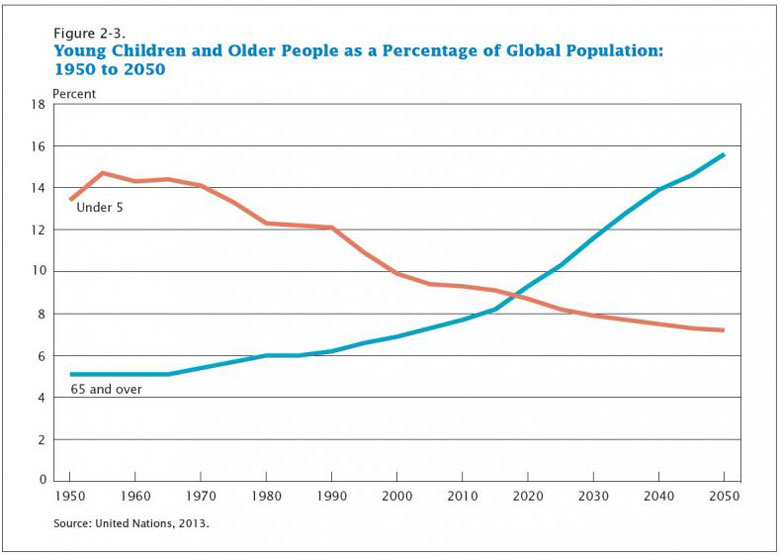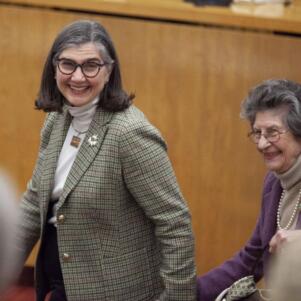‘First time in human history’ 65 and older will outnumber children under 5
By CNS News | April 1, 2016, 13:30 EDT
 (NewBostonPost photo by Beth Treffeisen)
(NewBostonPost photo by Beth Treffeisen) (CNSNews.com) — Sometime in the next four years the global population of human beings who are 65 and older will surpass those under 5 for the first time, according to a new report from the U.S. Census Bureau.
“For the first time in human history, people aged 65 and older will outnumber children under age 5,” says the report, entitled “An Aging World: 2015.”
“This crossing is just around the corner, before 2020,” says the report.
“These two age groups will then continue to grow in opposite directions,” it says. “By 2050, the proportion of the population 65 and older (15.6 percent) will be more than double that of children under age 5 (7.2 percent).
“This unique demographic phenomenon of the ‘crossing’ is unprecedented,” says the Census Bureau.

(Screen capture of chart in Census Bureau report)
The Census Bureau report included a ranking of “The World’s 25 Oldest Countries and Areas” in 2015 based on the percentage of the country’s population that was 65 or older.
While Japan ranked as the oldest country, the other 24 in the top 25 included 22 European countries, plus Canada and the U.S. territory of Puerto Rico.
The world’s youngest countries were in the Persian Gulf.
“The percentage of the population aged 65 and over in 2015 ranked from a high of 26.6 percent for Japan to a low of around 1 percent for Qatar and the United Arab Emirates,” said the report.
“Of the world’s 25 oldest countries and areas in 2015, 22 are in Europe, with Germany or Italy leading the ranks of European countries for many years, including currently.”
After Japan, with 26.6 percent of its population 65 or older, Germany ranked No. 2 with 21.5 percent of its population 65 or older. Italy ranked No. 3 with 21.2 percent of its population 65 or older; and Greece ranked No. 4 with 20.5 percent of its population 25 or older.
The Census Bureau report estimates that between now and 2050, the population that is 65 and older will more than double while the population under 20 years of age see almost no growth.
At the same time, those in what the report calls “the working age population”—people who are 20 to 64 years of age—will increase by only 25.6 percent.
“Among the 7.3 billion people worldwide in 2015, an estimated 8.5 percent, or 617.1 million, are aged 65 and older,” says the report. “The number of older people is projected to increase more than 60 percent in just 15 years—in 2030, there will be about 1 billion older people globally, equivalent to 12.0 percent of the total population.
“The share of older population will continue to grow in the following 20 years—by 2050, there will be 1.6 billion older people worldwide, representing 16.7 percent of the total world population of 9.4 billion,” says the report. “This is equivalent to an average annual increase of 27.1 million older people from 2015 to 2050.
“In contrast to the 150 percent expansion of the population aged 65 and over in the next 35 years, the youth population (under age 20) is projected to remain almost flat, 2.5 billion in 2015 and 2.6 billion in 2050,” the report says.
“Over the same period, the working-age population (aged 20 to 64) will increase only moderately, 25.6 percent,” the Census Bureau says. “The working-age population share of total population will shrink slightly in the decades to come, largely due to the impact of low fertility and increasing life expectancy.”
While there has been a global increase in human longevity, it is not the primary force driving the global population toward a demographic where the elderly will outnumber young children.
“The main demographic force behind population aging is declining fertility rates,” says the Census Bureau report. “Populations with high fertility tend to have a young age distribution with a high proportion of children and a low proportion of older people, while those with low fertility have the opposite, resulting in an older society.”
“In many countries today, the total fertility rate (TFR) has fallen below the 2.1 children that a couple needs to replace themselves,” says the report. “In 2015, the TFR is near or below replacement levels in all world regions except Africa.”
Europe has a particularly low fertility rate.
“The more developed countries in Europe, where fertility reduction started more than 100 years ago, have had TFR levels below replacement rate since the 1970s,” says the Census Bureau report. “Currently, the average TFR for Europe is a very low 1.6.”
In the United States in 2015, according to the report, 14.9 percent of the population is 65 or older. In 2050, the report estimates, 22.1 percent of the U.S. population will be 65 or older.
The Census Bureau report includes a sidebar on “Support of Childless Older People in an Aging Europe.”
“Traditionally, children are the mainstay of old age support, especially when only one parent is still living,” says this sidebar authored by researcher Martina Brandt at Dortmund University and Christian Deindl at University of Cologne. “However, people are not only living longer but also having fewer children, with rising childlessness among the older people.”
“Thus new challenges arise: Who will provide help and care to the childless older people?” they write. “On what support networks can they rely? And, what role does the state play in care provision?”
— Written by Terence P. Jeffrey











